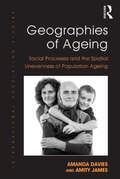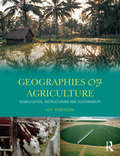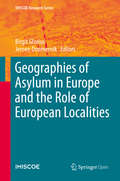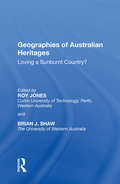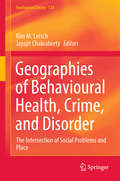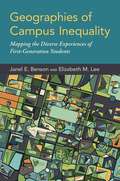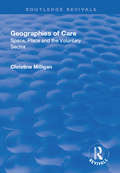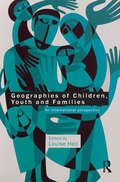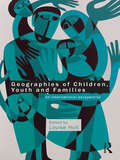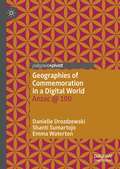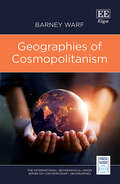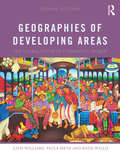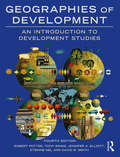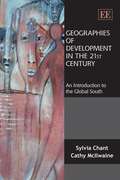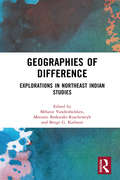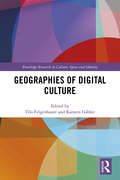- Table View
- List View
Geographies of Ageing: Social Processes and the Spatial Unevenness of Population Ageing
by Amanda Davies Amity JamesPopulation ageing is projected to affect all countries across the world in coming decades. The current rate of population ageing is unprecedented in human history with population projections indicating that this will be an enduring trend. Moreover, population ageing is spatially pervasive, affecting every man, woman and child. This has considerable implications for policy responding to the economic, social and healthcare outcomes of population ageing. The potential economic implications have been likened to those of the 2008 global financial crisis. This book examines the patterns and causes of uneven population ageing. It identifies those countries and localities most likely to experience population ageing and the reasons for this. Attention is also given to the role that youth migration, labour force migration, retirement migration and ageing in place have in influencing the spatial concentrations of older people. The book brings together a range of diverse international case studies to illustrate the importance of understanding the causes of population ageing. Case studies include a review of ageing in Florida's (USA) labour force, an investigation into the housing arrangements for the elderly in Northern Ireland and an assessment of the environmental stewardship activities of Grey Nomads on Western Australia's remote north coast.
Geographies of Ageing: Social Processes and the Spatial Unevenness of Population Ageing
by Amanda Davies Amity JamesPopulation ageing is projected to affect all countries across the world in coming decades. The current rate of population ageing is unprecedented in human history with population projections indicating that this will be an enduring trend. Moreover, population ageing is spatially pervasive, affecting every man, woman and child. This has considerable implications for policy responding to the economic, social and healthcare outcomes of population ageing. The potential economic implications have been likened to those of the 2008 global financial crisis. This book examines the patterns and causes of uneven population ageing. It identifies those countries and localities most likely to experience population ageing and the reasons for this. Attention is also given to the role that youth migration, labour force migration, retirement migration and ageing in place have in influencing the spatial concentrations of older people. The book brings together a range of diverse international case studies to illustrate the importance of understanding the causes of population ageing. Case studies include a review of ageing in Florida's (USA) labour force, an investigation into the housing arrangements for the elderly in Northern Ireland and an assessment of the environmental stewardship activities of Grey Nomads on Western Australia's remote north coast.
Geographies of Agriculture: Globalisation, Restructuring and Sustainability
by Guy RobinsonFirst published in 2003. Routledge is an imprint of Taylor & Francis, an informa company.
Geographies of Agriculture: Globalisation, Restructuring and Sustainability
by Guy RobinsonFirst published in 2003. Routledge is an imprint of Taylor & Francis, an informa company.
Geographies of Asylum in Europe and the Role of European Localities (IMISCOE Research Series)
by Birgit Glorius Jeroen DoomernikThis open access book describes how the numerous arrivals of asylum seekers since 2015 shaped reception and integration processes in Europe. It addresses the structuration of asylum and reception systems, and spaces and places of reception on European, national, regional and local level. It also analyses perceptions and discourses on asylum and refugees, their evolvement and the consequences for policy development. Furthermore, it examines practices and policy developments in the field of refugee reception and integration. The volume shows and explains a variety of refugee reception and integration strategies and practices as specific outcome of multilevel governance processes in Europe. By addressing and contextualizing those multiple experiences of asylum seeker reception, the book is a valuable contribution to the literature on migration and integration, societal development and political culture in Europe.
Geographies of Australian Heritages: Loving a Sunburnt Country?
by Roy Jones Brian J. ShawIn any settler and/or postcolonial society, heritage is a complex and contested topic that involves indigenous, imperial and other migrant components. In Australia, this situation is compounded by the unique characteristics of the country's natural environment, the considerable diversity of its migrant intake and the demographic and technological imbalances between its indigenous and settler populations. This volume brings together internationally recognized academics and emerging scholars, whose expertise extends through the areas of tourism, planning, heritage management, environmental studies and state and local government. Through a representative set of case studies from across the country's states and capital cities, the contributors demonstrate the range and diversity of heritage issues currently confronting Australia, and consider possible ways of resolving these.
Geographies of Australian Heritages: Loving a Sunburnt Country?
by Roy Jones Brian J. ShawIn any settler and/or postcolonial society, heritage is a complex and contested topic that involves indigenous, imperial and other migrant components. In Australia, this situation is compounded by the unique characteristics of the country's natural environment, the considerable diversity of its migrant intake and the demographic and technological imbalances between its indigenous and settler populations. This volume brings together internationally recognized academics and emerging scholars, whose expertise extends through the areas of tourism, planning, heritage management, environmental studies and state and local government. Through a representative set of case studies from across the country's states and capital cities, the contributors demonstrate the range and diversity of heritage issues currently confronting Australia, and consider possible ways of resolving these.
Geographies of Behavioural Health, Crime, and Disorder: The Intersection of Social Problems and Place (GeoJournal Library #126)
by Jayajit Chakraborty Kim M. LerschThis book focuses on the intersection of place and overall community health thereby focusing on some of the most critical contemporary social problems, including the opioid crisis, suicide, socioeconomic status and ethnicity, mental illness, crime, homelessness, green criminology, and social and environmental justice. Scholars from a variety of disciplines, including geography, sociology, criminology, mental health, social work, and behavioural sciences discuss the importance of geography in our quality of life. Each chapter introduces the reader to an overview of the topic, presents theoretical frameworks and the most recent empirical evidence, and discusses real world policy implications. As such this book is a key resource for researchers, policy makers, and practitioners working in the field.
Geographies of Campus Inequality: Mapping the Diverse Experiences of First-Generation Students
by Janel E. Benson Elizabeth M. LeeIn efforts to improve equity, selective college campuses are increasingly focused on recruiting and retaining first-generation students-those whose parents have not graduated from college. In Geographies of Campus Inequality, sociologists Benson and Lee argue that these approaches may fall short if they fail to consider the complex ways first-generation status intersects with race, ethnicity, and gender. Drawing on interview and survey data from selective campuses, the authors show that first-generation students do not share a universal experience. Rather, first-generation students occupy one of four disparate geographies on campus within which they negotiate academic responsibilities, build relationships, engage in campus life, and develop post-college aspirations. Importantly, the authors demonstrate how geographies are shaped by organizational practices and campus constructions of class, race, and gender. Geographies of Campus Inequality expands the understanding of first-generation students' campus lives and opportunities for mobility by showing there is more than one way to be first-generation.
Geographies of Campus Inequality: Mapping the Diverse Experiences of First-Generation Students
by Elizabeth M. Lee Janel E. BensonIn efforts to improve equity, selective college campuses are increasingly focused on recruiting and retaining first-generation students-those whose parents have not graduated from college. In Geographies of Campus Inequality, sociologists Benson and Lee argue that these approaches may fall short if they fail to consider the complex ways first-generation status intersects with race, ethnicity, and gender. Drawing on interview and survey data from selective campuses, the authors show that first-generation students do not share a universal experience. Rather, first-generation students occupy one of four disparate geographies on campus within which they negotiate academic responsibilities, build relationships, engage in campus life, and develop post-college aspirations. Importantly, the authors demonstrate how geographies are shaped by organizational practices and campus constructions of class, race, and gender. Geographies of Campus Inequality expands the understanding of first-generation students' campus lives and opportunities for mobility by showing there is more than one way to be first-generation.
Geographies of Care: Space, Place and the Voluntary Sector (Routledge Revivals)
by Christine MilliganThis title was first published in 2001. As care services in Britain have moved from institutional to community-based environments, there has been a simultaneous shift in those agencies concerned with the provision of such care and support. this new environment of care is a complex one, involving numerous different actors and agencies that operate across various different spatial and organizational levels of the policy process. The implementation and success of care policies depend in part on the inter-relationships between these various players. This book examines these inter-relationships, illustrated by an in-depth empirical study of policy makers and informal care providers concerned with the frail elderly in Scotland. Taking the voluntary sector as a lens through which these inter-relationships are explored, it analyzes how voluntary support is affected by differing local contexts of care and what this means in terms of locally based care outcomes.
Geographies of Care: Space, Place and the Voluntary Sector (Routledge Revivals)
by Christine MilliganThis title was first published in 2001. As care services in Britain have moved from institutional to community-based environments, there has been a simultaneous shift in those agencies concerned with the provision of such care and support. this new environment of care is a complex one, involving numerous different actors and agencies that operate across various different spatial and organizational levels of the policy process. The implementation and success of care policies depend in part on the inter-relationships between these various players. This book examines these inter-relationships, illustrated by an in-depth empirical study of policy makers and informal care providers concerned with the frail elderly in Scotland. Taking the voluntary sector as a lens through which these inter-relationships are explored, it analyzes how voluntary support is affected by differing local contexts of care and what this means in terms of locally based care outcomes.
Geographies of Children, Youth and Families: An International Perspective
by Louise HoltThis edited collection brings together international experts from the vibrant and growing field of geographies of children, youth and families. Designed as an introduction to the topic, this book provides an overview of current conceptual and theoretical debates surrounding geographies of children, youth and families, and gives a wide range of examples of cutting-edge research from a variety of national contexts across the globe. The theme of ‘disentangling the socio-spatial contexts of young people and/or their families’ advances debates in the field by emphasising the context of young people’s social agency. Geographies of Children, Youth and Families is an invaluable course text for undergraduate and postgraduate students of geography and the social sciences, as well as being of interest to students and practitioners of education, youth work, social policy, and social work.
Geographies of Children, Youth and Families: An International Perspective
by Louise HoltThis edited collection brings together international experts from the vibrant and growing field of geographies of children, youth and families. Designed as an introduction to the topic, this book provides an overview of current conceptual and theoretical debates surrounding geographies of children, youth and families, and gives a wide range of examples of cutting-edge research from a variety of national contexts across the globe. The theme of ‘disentangling the socio-spatial contexts of young people and/or their families’ advances debates in the field by emphasising the context of young people’s social agency. Geographies of Children, Youth and Families is an invaluable course text for undergraduate and postgraduate students of geography and the social sciences, as well as being of interest to students and practitioners of education, youth work, social policy, and social work.
Geographies of Commemoration in a Digital World: Anzac @ 100
by Danielle Drozdzewski Shanti Sumartojo Emma WatertonThis book reframes commemoration through distinctly geographical lenses, locating it within experiential and digital worlds. It interrogates the role of power in representations of memory and shows how experiences of commemoration sit within, alongside and in contrast to its official normative forms. The book charts how memories, places and experiences of commemoration play out and have, or have not, changed in and through a digital world. Key to the book’s exploration is a new epistemology of memory, underpinned by an embodied research approach.
Geographies of Cosmopolitanism (The International Geographical Union Series on Contemporary Geographies)
by Barney WarfInvigorating and timely, this book provides a thorough overview of the geographies of cosmopolitanism, an ethical and political philosophy that views humanity as one community. Barney Warf charts the origins and developments of this line of thought, exploring how it has changed over time, acquiring many variations along the way.Offering a comprehensive account of the theory and practice of cosmopolitanism at multiple spatial scales, chapters note how and why cosmopolitans reject the nation-state and nationalism and view borders as artificial. The book addresses the intersections between cosmopolitanism and geography, including care-giving and relational space. It examines key contemporary issues, including globalization, negotiating the post-Westphalian political order, the United Nations, global citizenship, immigration, refugees and sanctuary cities. Particular focus is also given to cosmopolitanism in everyday life, including education, tourism, consumption and veganism.Analysing cosmopolitanism in an interdisciplinary manner, Geographies of Cosmopolitanism will be an interesting read for sociology, human geography and political science scholars. It will also appeal to philosophy and social science students more broadly who are keen to understand this approach to social justice and human rights.
Geographies of Developing Areas: The Global South in a Changing World
by Glyn Williams Paula Meth Katie WillisGeographies of Developing Areas is a thought provoking and accessible introductory text, presenting a fresh view of the Global South that challenges students' pre-conceptions and promotes lively debate. Rather than presenting the Global South as a set of problems, from rapid urbanization to poverty, this book focuses on the diversity of life in the South, and looks at the role the South plays in shaping and responding to current global change. The core contents of the book integrate 'traditional' concerns of development geographers, such as economic development and social inequality, with aspects of the global South that are usually given less attention, such as cultural identity and political conflict. This edition has been fully updated to reflect recent changes in the field and highlight issues of security, risk and violence; environmental sustainability and climate change; and the impact of ICT on patterns of North-South and South-South exchange. It also challenges students to think about how space is important in both the directions and the outcomes of change in the Global South, emphasizing the inherently spatial nature of political, economic and socio-cultural processes. Students are introduced to the Global South via contemporary debates in development and current research in cultural, economic and political geographies of developing areas. The textbook consider how images of the so-called 'Third World' are powerful, but problematic. It explores the economic, political and cultural processes shaping the South at the global scale and the impact that these have on people's lives and identities. Finally, the text considers the possibilities and limitations of different development strategies. The main arguments of the book are richly illustrated through case study material drawn from across the Global South as well as full colour figures and photos. Students are supported throughout with clear examples, explanations of key terms, ideas and debates, and introductions to the wider literature and relevant websites in the field. The pedagogical features of the book have been further developed through discussion questions and activities that provide focused tasks for students' research, including investigation based around the book's case studies, and in-depth exploration of debates and concepts it introduces.
Geographies of Developing Areas: The Global South in a Changing World
by Glyn Williams Paula Meth Katie WillisGeographies of Developing Areas is a thought provoking and accessible introductory text, presenting a fresh view of the Global South that challenges students' pre-conceptions and promotes lively debate. Rather than presenting the Global South as a set of problems, from rapid urbanization to poverty, this book focuses on the diversity of life in the South, and looks at the role the South plays in shaping and responding to current global change. The core contents of the book integrate 'traditional' concerns of development geographers, such as economic development and social inequality, with aspects of the global South that are usually given less attention, such as cultural identity and political conflict. This edition has been fully updated to reflect recent changes in the field and highlight issues of security, risk and violence; environmental sustainability and climate change; and the impact of ICT on patterns of North-South and South-South exchange. It also challenges students to think about how space is important in both the directions and the outcomes of change in the Global South, emphasizing the inherently spatial nature of political, economic and socio-cultural processes. Students are introduced to the Global South via contemporary debates in development and current research in cultural, economic and political geographies of developing areas. The textbook consider how images of the so-called 'Third World' are powerful, but problematic. It explores the economic, political and cultural processes shaping the South at the global scale and the impact that these have on people's lives and identities. Finally, the text considers the possibilities and limitations of different development strategies. The main arguments of the book are richly illustrated through case study material drawn from across the Global South as well as full colour figures and photos. Students are supported throughout with clear examples, explanations of key terms, ideas and debates, and introductions to the wider literature and relevant websites in the field. The pedagogical features of the book have been further developed through discussion questions and activities that provide focused tasks for students' research, including investigation based around the book's case studies, and in-depth exploration of debates and concepts it introduces.
Geographies of Development: An Introduction to Development Studies
by Robert Potter Tony Binns Jennifer A. Elliott Etienne Nel David W. SmithNow in its fourth edition, Geographies of Development: An Introduction to Development Studies remains a core, balanced and comprehensive introductory textbook for students of Development Studies, Development Geography and related fields. This clear and concise text encourages critical engagement by integrating theory alongside practice and related key topics throughout. It demonstrates informatively that ideas concerning development have been many and varied and highly contested - varying from time to time and from place to place. Clearly written and accessible for students, who have no prior knowledge of development, the book provides the basics in terms of a geographical approach to development what situation is, where, when and why. Over 200 maps, charts, tables, textboxes and pictures break up the text and offer alternative ways of showing the information. The text is further enhanced by a range of pedagogical features: chapter outlines, case studies, key thinkers, critical reflections, key points and summaries, discussion topics and further reading. Geographies of Development continues to be an invaluable introductory text not only for geography students, but also anyone in area studies, international studies and development studies.
Geographies of Development: An Introduction to Development Studies
by Robert Potter Tony Binns Jennifer A. Elliott Etienne Nel David W. SmithNow in its fourth edition, Geographies of Development: An Introduction to Development Studies remains a core, balanced and comprehensive introductory textbook for students of Development Studies, Development Geography and related fields. This clear and concise text encourages critical engagement by integrating theory alongside practice and related key topics throughout. It demonstrates informatively that ideas concerning development have been many and varied and highly contested - varying from time to time and from place to place. Clearly written and accessible for students, who have no prior knowledge of development, the book provides the basics in terms of a geographical approach to development what situation is, where, when and why. Over 200 maps, charts, tables, textboxes and pictures break up the text and offer alternative ways of showing the information. The text is further enhanced by a range of pedagogical features: chapter outlines, case studies, key thinkers, critical reflections, key points and summaries, discussion topics and further reading. Geographies of Development continues to be an invaluable introductory text not only for geography students, but also anyone in area studies, international studies and development studies.
Geographies Of Development In The 21st Century
by Sylvia Chant Cathy McllwaineWritten by two widely published academics with many years' experience in university teaching, research and consultancy, Geographies of Development in the 21st Century provides a concise yet informative introduction to development in the contemporary Global South. Incorporating field research from Mexico, Costa Rica, Guatemala, Colombia, El Salvador, the Philippines, Botswana and The Gambia, Sylvia Chant and Cathy McIlwaine bring alive a body of fascinating subject matter extending across gender, family, poverty, employment, household livelihoods, the informal economy, housing, migration, civil society, conflict and violence. Reflecting both authors' enduring interests in the academic-policy interface, the book is also informed by assignments they have undertaken for various international organisations such as the World Bank, Inter-American Development Bank, UNDP, UNICEF, ILO and the Commonwealth Secretariat. This timely and engaging volume will be an essential companion for undergraduate students taking introductory courses in development and globalisation as well as a useful reference and repository of teaching and learning ideas for those lecturing on the subject. Students will not only find this resource refreshingly accessible and user-friendly, but will be able to further their knowledge guided by annotated readings, key internet sources
Geographies of Difference: Explorations in Northeast Indian Studies
by Mélanie Vandenhelsken Meenaxi Barkataki-Ruscheweyh Bengt G. KarlssonThis book rethinks Northeast India as a lived space, a centre of interconnections and unfolding histories, instead of an isolated periphery. Questioning dominant tropes and assumptions around the Northeast, it examines socio-political and historical processes, border issues, the role of the state, displacement and development, debates over natural resources, violence, notions of body and belonging, movements, tensions and relations, and strategies, struggles and narratives that frame discussions on the region. Drawing on current and emerging research in Northeast India studies, this work will be of great interest to scholars and researchers of politics, human geography, sociology and social anthropology, history, cultural studies, media studies and South Asian studies.
Geographies of Difference: Explorations in Northeast Indian Studies
by Mélanie Vandenhelsken Meenaxi Barkataki-Ruscheweyh Bengt G. KarlssonThis book rethinks Northeast India as a lived space, a centre of interconnections and unfolding histories, instead of an isolated periphery. Questioning dominant tropes and assumptions around the Northeast, it examines socio-political and historical processes, border issues, the role of the state, displacement and development, debates over natural resources, violence, notions of body and belonging, movements, tensions and relations, and strategies, struggles and narratives that frame discussions on the region. Drawing on current and emerging research in Northeast India studies, this work will be of great interest to scholars and researchers of politics, human geography, sociology and social anthropology, history, cultural studies, media studies and South Asian studies.
Geographies of Digital Culture (Routledge Research in Culture, Space and Identity)
by Tilo Felgenhauer Karsten Gäbler“Digital culture” reflects the ways in which the ubiquity and increasing use of digital devices and infrastructures is changing the arenas of human experience, creating new cultural realities. Whereas much of the existing literature on digital culture addresses the topic through a sociological, anthropological, or media theoretic lens, this book focuses on its geographic aspects. The first section, “infrastructures and networked practices” highlights the integration of digital technologies into everyday practices in very different historical and geographical contexts—ranging from local lifeworlds, urban environments, web cartographies up to global geopolitics. The second section on “subjectivities and identities” shows how digital technology use possesses the capacity to alter the subjective, perceptive, and affective engagement with the spatial world. Finally, “politics and inequalities” investigates the social and spatial disparities concerning digital technology and its use. This book draws attention to the deep interconnectedness of the cultural, digital, and spatial aspects of everyday practices by referring to a broad range of empirical examples taken from tourism, banking, mobility, and health. Scholars in human geography, anthropology, media and communication studies, and history will find this research indispensable reading. It addresses both young and seasoned researchers as well as advanced students in the aforementioned disciplines. The wealth of examples also makes this publication helpful in academic teaching.
Geographies of Digital Culture (Routledge Research in Culture, Space and Identity)
by Tilo Felgenhauer Karsten Gäbler“Digital culture” reflects the ways in which the ubiquity and increasing use of digital devices and infrastructures is changing the arenas of human experience, creating new cultural realities. Whereas much of the existing literature on digital culture addresses the topic through a sociological, anthropological, or media theoretic lens, this book focuses on its geographic aspects. The first section, “infrastructures and networked practices” highlights the integration of digital technologies into everyday practices in very different historical and geographical contexts—ranging from local lifeworlds, urban environments, web cartographies up to global geopolitics. The second section on “subjectivities and identities” shows how digital technology use possesses the capacity to alter the subjective, perceptive, and affective engagement with the spatial world. Finally, “politics and inequalities” investigates the social and spatial disparities concerning digital technology and its use. This book draws attention to the deep interconnectedness of the cultural, digital, and spatial aspects of everyday practices by referring to a broad range of empirical examples taken from tourism, banking, mobility, and health. Scholars in human geography, anthropology, media and communication studies, and history will find this research indispensable reading. It addresses both young and seasoned researchers as well as advanced students in the aforementioned disciplines. The wealth of examples also makes this publication helpful in academic teaching.
